Late Antiquity - Recent acquisitions - Sold antiquities
Archive of sold antiquities
All artefacts sold in our gallery are fully documented in our online archive and database. Being a specialist ancient art dealer, preserving also the more recent history of each and every piece sold in our shop is at our heart. That is particularly useful for artefacts that changed owners in the meantime. Information that may have been lost in the process can be easily restored from our archives. Please do not hesitate to contact us if you need further information about ancient items that have been sold in our gallery. We can help you with reconstructing the history of ownership for those items. All information about our customers will be kept confidential, of course.-
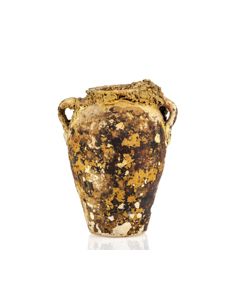 Large post-antique vase with nice sea encrustation
Large post-antique vase with nice sea encrustationPerfectly preserved. Found 1967 in the sea in Croatia, exported with permit of the local authorities.
Price: on request Nicely preserved St. Menas flask
Nicely preserved St. Menas flaskEarly Christian pilgrim flask with the depiction of St. Menas between camels. From the estate of a high-ranking German diplomat, in his collection since at least 1972.
Price: on request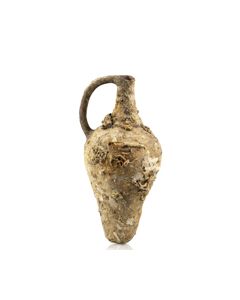 Byzantine amphora with nice sea encrustation
Byzantine amphora with nice sea encrustationVery good condition. Found 1967 in the sea in Croatia, exported with permit of the local authorities.
Price: on request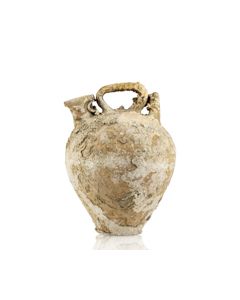 Interesting large byzantine handle jug with nice sea encrustation
Interesting large byzantine handle jug with nice sea encrustationImpressive vessel with distinct maritime aesthetics. Found 1967 in the sea in Croatia, exported with permit of the local authorities.
Price: on request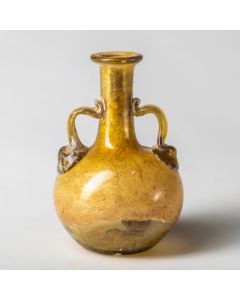 Roman glass bottle with handles
Roman glass bottle with handlesThe glass impresses with its elegant shape. Made in one of the Roman glass factories in the eastern Mediterranean during the Late Imperial period.
Price: on request Byzantine glass pendant from Judaea
Byzantine glass pendant from JudaeaThe pendant shows Romulus and Remus being suckled by a she-wolf. It was worn as a lucky charm or protective amulet. Made in the early Byzantine period in a glass workshop in Judaea.
Price: on request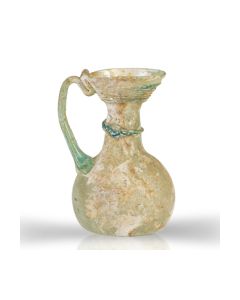 Roman glass pitcher
Roman glass pitcherFine and beautifully decorated glass pitcher from Roman Palestine, probably from an ancient workshop in what is now Jalamah. Around 500 AD.
Price: on request Byzantine glass pendant from Judaea
Byzantine glass pendant from JudaeaThe pendant with a lion and crescent motif was worn as a lucky charm or protective amulet. Made in the early Byzantine period in a glass workshop in Judaea.
Price: on request Late Roman glass flask
Late Roman glass flaskFlat bottle with double handle from the Eastern Mediterranean. Made between the 3rd and 6th century.
Price: on request Sassanian intaglio with griffin
Sassanian intaglio with griffinPerfectly preserved ring stone made of orange carnelian. It shows a winged hybrid creature with the body of a lion. With inscription in Pahlavi, the Middle Persian script of the Sassanids.
Price: on request Bronze bird from Late Antiquity
Bronze bird from Late AntiquityFinial in the shape of a bird, probably once the head of a rod or distaff. From the Late Roman or Early Byzantine period.
Price: on request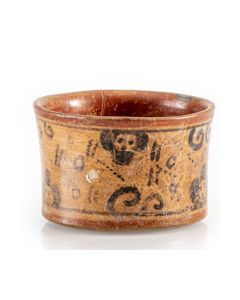 Maya civilization pottery bowl
Maya civilization pottery bowlSmall bowl painted with abstract shapes. From the Classic period of the Maya civilization.
Price: on request Egyptian die made of bone
Egyptian die made of boneOld find from Abydos made by the Egyptian Exploration Fund (today: EES). It is an early die with round markings. Ancient Egypt.
Price: on request Pair of early Byzantine gold earrings
Pair of early Byzantine gold earringsBeautiful jewellery with beads made of emerald and garnet. Made in the eastern part of the Mediterranean during the 6th to early 7th century.
Price: on request Roman sprinkler
Roman sprinklerPerfume bottle with pattern-blown body. An aperture made it easy to dispense the precious content drop by drop. From the Late Roman period.
Price: on request Roman globular bottle
Roman globular bottlePerfectly preserved glass vessel with globular body. Made in the Eastern Mediterranean during late Roman Imperial times.
Price: on request Amphora with beautiful marina patina
Amphora with beautiful marina patinaTable amphora, or vessel for transport of particularly precious goods. The beautiful dense marine patina makes this vase a true eye-catcher. From the Austrian collection of Prof. Ritschel, carrier of the Large Cross of Honor of the Austrian Republic and many other prizes and honors.
Price: on request Early Islamic glass with spiral thread
Early Islamic glass with spiral threadA marvelous example for Early Islamic glass after the conquest of the Levant, during Umayyad rule. A glass from the professor Ritschel collection.
Price: on request Published coptic bronze figurine of an angel
Published coptic bronze figurine of an angelBetween 1963 and 2009 on exhibition in Vienna, Zurich, Basel and Clermont-Ferrand. Reported to have been found in Middle Egypt. From the famous Prof. Maurice Bouvier collection, acquired in Egypt between 1929 and 1959.
Price: on request Roman transport amphora
Roman transport amphoraNicely preserved, large amphora with attractive marine patina. Acquired in the 1980s from Helmut Liebert Antiquities in Krefeld, Germany.
Price: on request Published coptic bronze figurine of a sitting woman
Published coptic bronze figurine of a sitting womanBetween 1963 and 2009 on exhibition in Vienna, Zurich, Basel and Clermont-Ferrand. Reported to have been found in Middle Egypt. From the famous Prof. Maurice Bouvier collection, acquired in Egypt between 1929 and 1959.
Price: on request Late antique oil lamp with round body
Late antique oil lamp with round bodyPossibly from Israel area. Excellent condition. From the collection of Prof. Ritschel, Salzburg, decorated many times, for example in 1995 when the Republic of Austria awarded its Decoration for Science and Art.
Price: on request Published coptic bronze figurine of a standing woman
Published coptic bronze figurine of a standing womanBetween 1963 and 2009 on exhibition in Vienna, Zurich, Basel and Clermont-Ferrand. Reported to have been found in Middle Egypt. From the famous Prof. Maurice Bouvier collection, acquired in Egypt between 1929 and 1959.
Price: on request Roman transport amphora found at Sezze
Roman transport amphora found at SezzeNicely preserved, large amphora from the Mediterranean sea. Attractive marine patina. Found in Sezze area (Latium).
Price: on request Roman transport amphora found at Cabrera island
Roman transport amphora found at Cabrera islandPerfectly preserved, large amphora from the Mediterranean sea. From an old German collection.
Price: on request Roman transport amphora found at Cabrera island
Roman transport amphora found at Cabrera islandNicely preserved amphora from the Mediterranean sea. From an old German collection.
Price: on request Roman transport amphora found at Cabrera island
Roman transport amphora found at Cabrera islandPerfectly preserved, large amphora from the Mediterranean sea. From an old German collection.
Price: on request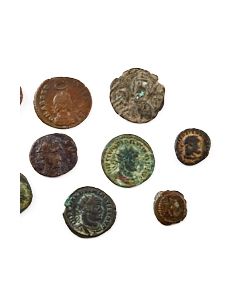 11 Roman coins from an old German collection
11 Roman coins from an old German collectionThe small collection features different emperors from the late Roman Empire and the early Byzantine era. From the collection of Prof. Schmid, acquired in the late 1970s - early 1980s.
Price: on request Beaker of the Nazca culture
Beaker of the Nazca cultureElegant vessel made by the precolumbian Nazca culture. The outside is decorated by a polychrome szene of geometric patterns and abstractions of animals and faces.
Price: on request Roman transport amphora found at Cabrera island
Roman transport amphora found at Cabrera islandPerfectly preserved, large amphora from the Mediterranean sea. Attractive marine patina.
Price: on request Egyptian frog lamp from very old German collection
Egyptian frog lamp from very old German collectionThe frog lamps developed in Egypt close to Abydos. For the Egyptians, the frog symbolized birth and resurrection, this symbolism was also adapted by the early Christians. From the German collection Becker, in this for 3 generations.
Price: on request Roman oil lamp with head of a Taurus as handle
Roman oil lamp with head of a Taurus as handleRare type with plastic handle and large cross on base.
Price: on request North African oil lamp with floral motif
North African oil lamp with floral motifDark clay with partially preserved dark glaze. Nicely preserved, from an old collection.
Price: on request North African oil lamp - very rare type
North African oil lamp - very rare typeDark clay with partially preserved dark green glaze, very rare transition type. Nicely preserved, from an old German collection.
Price: on request Roman provincial fibula of the horsemen
Roman provincial fibula of the horsemenThe swastika shaped brooch with horse head terminals was worn by the cavallery in Late Antiquity. In particular by the troops recruited by the Romans from their Pannonian Foederati. It might have been a symbol for strength or designated a military rank.
Price: on request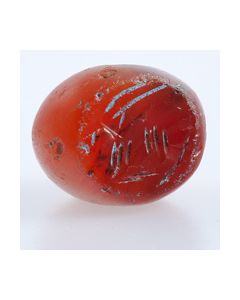 Sassanidisches Stempelsiegel mit springender Antilope
Sassanidisches Stempelsiegel mit springender AntilopeDunkler orangefarbener Karneol, der Stempel zeigt eine stilisierte springende Antilope. Hervorragender Zustand. Inklusive Stempelabdruck.
Price: on request

